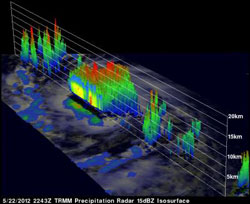NASA's TRMM satellite sees heavy rainfall in Tropical Storm Bud

The TRMM satellite passed over Bud on May 22, 2012, at 6:43 p.m. EDT. This 3-D image from TRMM shows that some of the strong convective towers near Bud's center were taller than 15 km (~9.3 miles). Credit: NASA/TRMM, Hal Pierce<br>
The TRMM satellite had an excellent view of tropical storm Bud on May 22, 2012 at 2243 UTC 6:43 p.m. EDT/2:43 p.m. PDT). TRMM's Microwave Imager (TMI) and Precipitation Radar (PR) data shows that Bud contained bands of very heavy rainfall near the center of circulation. TRMM revealed that some of these intense storms were dropping rainfall at a rate greater than 50mm/hr (~2 inches).
A 3-D image from TRMM's PR shows that some of the strong convective towers near Bud's center were taller than 15km (~9.3 miles). TRMM PR found reflectivity values of over 58.050 dBz indicating that very heavy rainfall was occurring.
On May 23, at 1500 UTC (8 a.m. PDT) Tropical Storm Bud's maximum sustained winds were near 65 mph (100 kph). It was located near latitude 13.4 North and longitude 107.6 West, about 445 miles (715 km) south-southwest of Manzanillo, Mexico. Bud is headed northwest near 9 mph (15 kph) and is expected to slow down, according to the National Hurricane Center (NHC).
The NHC also forecasts that Bud will slow and turn to the north-northeast by Friday, May 25. NHC stated that Bud could become a hurricane later today (May 23) or tonight.
Media Contact
More Information:
http://www.nasa.govAll latest news from the category: Earth Sciences
Earth Sciences (also referred to as Geosciences), which deals with basic issues surrounding our planet, plays a vital role in the area of energy and raw materials supply.
Earth Sciences comprises subjects such as geology, geography, geological informatics, paleontology, mineralogy, petrography, crystallography, geophysics, geodesy, glaciology, cartography, photogrammetry, meteorology and seismology, early-warning systems, earthquake research and polar research.
Newest articles

High-energy-density aqueous battery based on halogen multi-electron transfer
Traditional non-aqueous lithium-ion batteries have a high energy density, but their safety is compromised due to the flammable organic electrolytes they utilize. Aqueous batteries use water as the solvent for…

First-ever combined heart pump and pig kidney transplant
…gives new hope to patient with terminal illness. Surgeons at NYU Langone Health performed the first-ever combined mechanical heart pump and gene-edited pig kidney transplant surgery in a 54-year-old woman…

Biophysics: Testing how well biomarkers work
LMU researchers have developed a method to determine how reliably target proteins can be labeled using super-resolution fluorescence microscopy. Modern microscopy techniques make it possible to examine the inner workings…





















